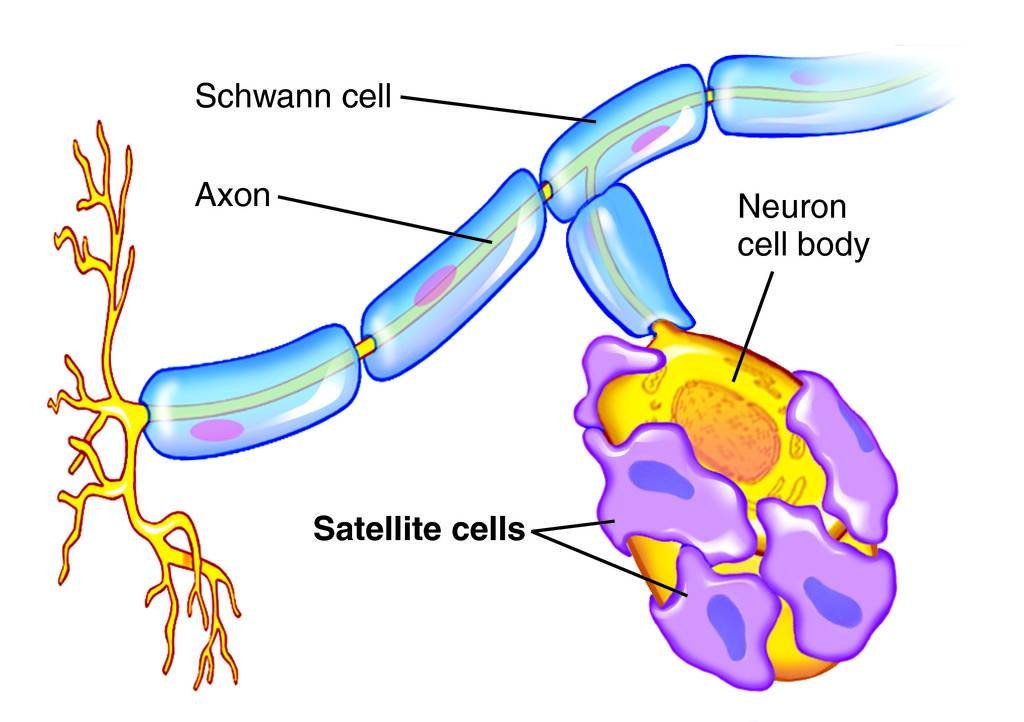Answer: Satellite glial cells are non-neuronal cells that form close interactions with neuronal ganglia of the peripheral nervous system.
Satellite glia are found exclusively in the peripheral nervous system (PNS), the nerves outside of the brain and spinal cord. Here, they form close associations with the cell bodies of some neurons. The distance between a satellite glia and the neuron cell body is estimated to be about 20 nanometers, similar to the distance of a typical chemical synapse. Because of this close interaction, they are believed to signal to one another using a variety of released chemical factors.
Morphologically, these cells are not extensively branched like astrocytes. Instead, they are much flatter. They do not form endfeet that contact blood vessels like astrocytes do. Additionally, they do not form myelin, since they are found surrounding neuronal cell bodies rather than their axons. (Emerging importance of satellite glia in nervous system function and dysfunction)
Multiple satellite glial cells are often interconnected through gap junctions, which allow for the diffusion of intracellular ions and signaling molecules between cells.
Satellite glial cells can be found surrounding the somata of cell bodies found in the peripheral nervous system ganglia. We have ganglia for our peripheral sensory systems, such as the somatosensory systems that detect pain or temperature.
Another major component of the PNS is the autonomic nervous system, which includes the sympathetic and parasympathetic nervous systems. The cell bodies of the nerves that make up the autonomic nervous system also form peripheral ganglia, and these somata are also surrounded by satellite glial cells.
Functions of satellite glial cells
Satellite glia can be thought of functionally as the astrocytes of the peripheral nervous system. They express several different types of ions channels within their cell membranes. Because they exist in such close proximity to the neurons, these satellite contribute heavily to the excitability profile of PNS neurons.
For example, the satellite glia express the inward rectifying potassium channel subunit Kir4.1. The Kir4.1 channels allow potassium ions to move into the cell more easily than out of the cell, which is not predicted by the Nernst equation (Inwardly Rectifying Potassium Channels: Their Structure, Function, and Physiological Roles). This ion channel subunit is also expressed specifically in CNS astrocytes, drawing another parallel to their similarities (Inwardly Rectifying Potassium Channel Kir4.1 as a Novel Modulator of BDNF Expression in Astrocytes). High extracellular concentrations of potassium ions lead to increased neuronal excitability, because of the shift of membrane potential towards depolarized values, as predicted by the Goldman-Hodgkin-Katz equation. Because these inward rectifying channels decrease the extracellular concentration of potassium ions, these channels have been implicated in the development of chronic pain conditions (Peripheral inflammation suppresses inward rectifying potassium currents of satellite glial cells in the trigeminal ganglia), which could result from changes in the excitability profile of the pain sensory neurons.
These satellite glia also express transient receptor potential vanilloid 4 (TRPV4) channels. These ion channels are calcium permeable and nonselective cation channels expressed in the cell membrane. These TRPV4 channels are implicated in the sensation of pain and itch. Furthermore, they can be activated by purinergic receptor activation, particularly the P2Y1 subpopulation (P2Y1 Receptor Activation of the TRPV4 Ion Channel Enhances Purinergic Signaling in Satellite Glial Cells).
They are likely involved in inflammation and nerve injury. These cells can be activated in response to injury, causing an upregulation of the synthesis of cytokines, which are proinflammatory cellular signaling molecules. This suggests that the satellite glial cells may be a novel target for inhibiting inflammatory pain, a type of pain that causes hypersensitivity to physical stimuli, whether noxious or innocuous (Mechanisms of inflammatory pain).
Historically, satellite glial cells were called amphicytes.
